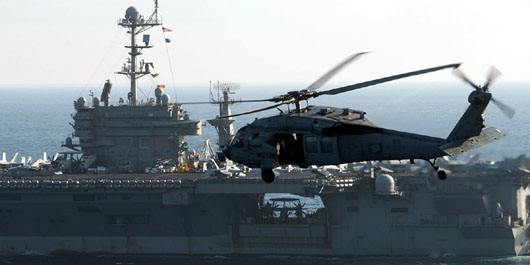Special to WorldTribune.com
Considered by many historians as the most successful alliance in history, the 89-year-old North American Treaty Organization has a new lease on life.
NATO’s largest war games in more than 16 years, the Trident Juncture exercise in Norway, Oct. 25-Nov. 10, will include more than 45,000 Alliance troops combining land, air and sea elements. It will include about 150 aircraft, more than 60 ships and 10,000 rolling or tracked vehicles. [The USS Harry S. Truman aircraft carrier strike group and its 6,000 service members will participate.]

The U.S. had already increased its military presence in Norway in recent years by adding a quasi-permanent force of some 300 Marines with a planned doubling soon.
Although the exercise would take place more than 600 miles from Russia and NATO aircraft won’t be within 300 miles of the former Soviet Union, it’s no secret why the Alliance has again gone into high gear: Russian Dictator Vladimir Putin’s seizure of Crimea in 2014, his continued support for armed dissidents in eastern Ukraine and his propaganda against the three Baltic states the Soviets once ruled, have again raised the spectacle of Russian aggression.
Meanwhile, the current exercise comes after a contentious NATO summit in the summer when President Donald K. Trump threatened to withdraw American membership unless other members raised their contributions.
“I let them know that I was extremely unhappy with what was happening” about defense spending, he said. “And as a result, they are going to up it to levels like they have never thought it before. What they are doing are spending at a much faster clip,” he said.
NATO was established in 1949 for the purpose of providing collective security against Soviet expansion. Ten European nations signed on to the original agreement along with the United States and Canada. In signing the treaty, the original members agreed that “an armed attack against one or more of them … shall be considered an attack against them all” to which each member would respond by taking “such action as it deems necessary, including the use of armed force.”
Trump in the heated closed-door session warned: “I can do whatever I want because this alliance has no legitimacy.” Trump was quoted telling the other delegates that “spending must be raised by January 2019 or the U.S. would go it alone.”
Trump also tangled with Germany’s Prime Minister Angela Merkel arguing she was beholden to Moscow over Berlin’s involvement in the Nord Stream gas pipeline project aimed at doubling Russia energy imports. The issue has become even more aggravated with the U.S. now potentially again an energy exporter with the enormous breakthrough in the development of shale oil and gas.
But in subsequent public statements following the tiff, he said “… that the United States had not been treated fairly but now we are. I believe in NATO; NATO is now a fine-tuned machine,” he said.
As of 2014, NATO’s collective agreement instructed member countries to spend 2 percent of their gross domestic product on defense by 2024.
As of June 2017, in NATO’s most recent estimate, only six nations met the 2 percent target for participants: the United States, Greece, the United Kingdom, Estonia, Poland and Romania.
Trump had demanded that members must double their defense spending to 4 per cent of GDP. He now claims “total credit” for other members raising their defense spending by $33 billion last year and a big splurge allegedly due to come
Sol W. Sanders, ([email protected]), is a contributing editor for WorldTribune.com and Geostrategy-Direct.com.

